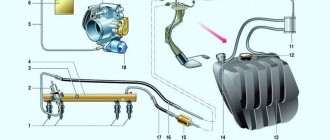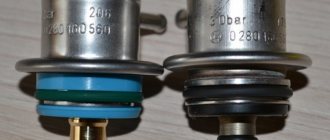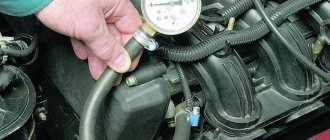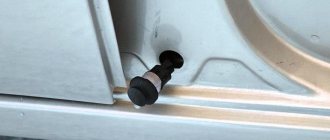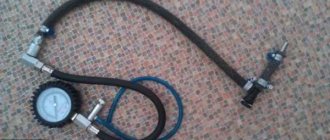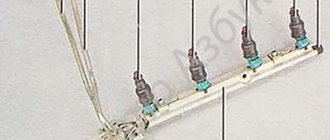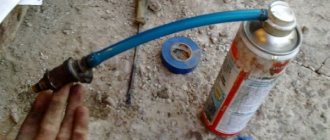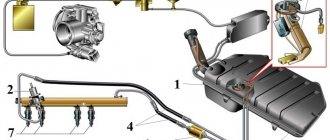03 February 2016 Lada.Online 79 913 1
Is the car jerking, loss of agility or the engine is difficult to start? One of the reasons for such malfunctions may be related to fuel pressure. Let's look at the instructions for measuring pressure in the fuel rail, as well as features that may arise during this activity.
Checking the fuel pressure is carried out similarly for all Lada cars (Granta, Kalina, Priora, Largus, Vesta, Niva 4x4 and XRAY), because All these models have the same type of engines.
Lada 2114 › Logbook › Fuel pressure. RTD.Fuel pump module
I sat at the computer all week, reviewed and re-read a lot of information on my topic with these damn phrases. They write a lot, and I take pictures, that the speed may fluctuate due to low pressure in the fuel system. I decided to check it out. I don’t have a pressure gauge, but I do have a compressor for inflating the wheels)
On the lower part on the reverse side there is a convenient valve that can be used to carefully release the pressure after measurement, so as not to spill everything with gasoline. My measurement showed exactly 3 kg. I thought and thought, what is the reason for the low pressure: the pump or the fuel pressure regulator (FPR)? Che came up with it. I reassembled the compressor, connected it to the ramp and began pumping air. The arrow has risen to 3 points and is holding, but the RTD should drop by 3.6-4 bar (360-400 kPa). I decided to make a control measurement by connecting the pump to the fuel pump module, otherwise suddenly the pressure was lost somewhere in the tubes. But unfortunately the result has not changed. I went to the service center for diagnostics, where they told me that there was air being sucked in somewhere, they measured the pressure in the ramp - still the same 3 points, they said this is the norm. I didn’t argue and went for a new regulator and fuel filter.
It took me a long time to figure out which RTD I should have with the salesperson at the store. It was not possible to remove yours and bring it as a sample. Only 3.8 bar (380 kPa) was available. I took it and installed it on site. The revs just float. Already in despair, I took a new fuel pump module assembly.
But this didn’t help either! I measure the pressure with the new module, and there are still the same 3 bars. Perhaps it’s worth checking what kind of RTD and how many kPa it costs in the new module and check how much it actually holds, but that’s in the next post, for today I’m already tired of this four. PS Maybe someone put 1.6 8v on the four, GAZ RTD at 400 kPa?
Mileage: 107,000 km
VAZ 2114 fuel pressure regulator - how to replace it + Video
The fuel pressure regulator (FPR) on the VAZ 2114 is necessary to maintain constant fuel pressure in the vehicle’s fuel system under various engine operating conditions.
An RTD is, in fact, a diaphragm-type safety valve that is mounted in the fuel rail (rail) of the car engine injectors. On the one hand, the pressure regulator is influenced by the pressure in the fuel system, on the other hand, by the spring pressure and the phenomenon of rarefaction of air in the pipe (intake).
The regulator we are interested in is serviced together with the above-mentioned ramp, since the RTD is its integral part.
Three main functions of the VAZ 2114 regulator:
- A decrease in fuel pressure as it decreases in the intake pipe.
- Maintaining pressure in the nozzles at a constant level.
- Load compensation under various vehicle engine operating modes.
Symptoms of malfunctions of Samara-2 RTD
The following phenomena indicate that the VAZ 2114 fuel pressure regulator may have a problem:
- at idle, the crankshaft rotates unstably;
- the engine requires a lot of fuel;
- starting the internal combustion engine is noticeably difficult;
- when driving, the car shows a lack of power;
- at idle speed the engine may suddenly stop;
- a high content of CH and CO is recorded in the exhaust.
These symptoms may appear in the following situations:
- low fuel quality (if you constantly use gasoline that is diluted with water, regulator failure is inevitable);
- long periods of vehicle downtime.
You can accurately determine the reason for the failure of the RTD yourself, using a standard pressure gauge for this purpose. With its help, you should determine what pressure is available in the fuel system.
Moreover, measurements must be made at different operating modes of the car engine:
- with RTD with the tube removed (the norm is a pressure of 3.3 atmospheres);
- at idle (normal - 2.5 atmospheres);
- when the return flow pipe is in a pinched state (the norm is 7 atmospheres);
- when the ignition is turned on (the norm is 3 or more atmospheres).
To take measurements, a pressure gauge is placed between the fitting and the fuel. Do not forget to first disconnect the vacuum hose, and also inspect the fuel line for mechanical defects. If fuel leaks anywhere, the reliability of the measurements will be extremely low.
The process of replacing the regulator at Samara-2
Dismantling of the RTD can only be carried out when the internal combustion engine is cold. The process of removing the regulator is carried out according to the diagram below:
- the negative wire is discarded from the battery;
- the nuts that are located on the drain pipe are dismantled (in this case, the pressure in the system decreases, and in order for it to occur normally, it is advisable to hold the hose fitting with your hand);
- using a rubber ring, connect the tube and the washer;
- After this, you should remove the clamping bar by removing the screw securing it.
Then you need to slightly loosen the nut designed to support the drain pipe and the RTD, and unscrew the fasteners connecting the ramp and the regulator. Having carefully completed this operation, you can completely unscrew the nut and remove the device we need from the ramp.
Installation of a new regulator is performed in the reverse manner. It seems that such a process will not cause any particular difficulties for a more or less experienced driver. If you think that you cannot cope with the installation of the RTD, simply contact the nearest service station.
see also
Comments 15
My revs have been fluctuating since I bought the car. It rarely happens that the engine runs perfectly smoothly and without interruptions (this is some kind of miracle), and then this lasts no more than 1-2 minutes. And so there are always slight twitches, and the tachometer floats slightly from 840-880 rpm. Already over a distance of 216 thousand km... I tried to look for air leaks, all the hoses (especially the small ventilation of the boat, and from the absorber. Most often, everyone does not hold it tightly, the hose rotates easily.) are sealed with sealant. The rubber seals on the manifold connection were also replaced during disassembly engine. I THINK THAT THE PROBLEM LIES IN A POORLY WRITTEN PROGRAM ON THE ECU, ALTHOUGH IT IS FINE (ALTHOUGH IT IS FISHED). A friend also had a 2114 but 1.5 8V, that’s who I envied at idle speed. Well, it just worked perfectly smoothly, without any twitching. The tachometer stood dead at 860 rpm. Although the car was much older than mine. This is my opinion and what the heck...
I had a V8 converted to an indexer and a VAZ 2111, they didn’t have such a problem, so that when you press the pedal a little, the revolutions would float. There were problems with idle, but everything was solved by arranging an air leak or replacing the sensor, but here I don’t know what else could happen.
My revs have been fluctuating since I bought the car. It rarely happens that the engine runs perfectly smoothly and without interruptions (this is some kind of miracle), and then this lasts no more than 1-2 minutes. And so there are always slight twitches, and the tachometer floats slightly from 840-880 rpm. Already over a distance of 216 thousand km... I tried to look for air leaks, all the hoses (especially the small ventilation of the boat, and from the absorber. Most often, everyone does not hold it tightly, the hose rotates easily.) are sealed with sealant. The rubber seals on the manifold connection were also replaced during disassembly engine. I THINK THAT THE PROBLEM LIES IN A POORLY WRITTEN PROGRAM ON THE ECU, ALTHOUGH IT IS FINE (ALTHOUGH IT IS FISHED). A friend also had a 2114 but 1.5 8V, that’s who I envied at idle speed. Well, it just worked perfectly smoothly, without any twitching. The tachometer stood dead at 860 rpm. Although the car was much older than mine. This is my opinion and what the heck...
I also know that there were some bad firmware, you need to look at the version
On injection Volgas, the RTDs are the same as ours, only at higher pressure - in my opinion, 4 bar. Although 3 bar is normal for our cars, the lower bar is 2.8, the upper one is 3.6. Your revolutions do not fluctuate for this.
2.6-3 is on 1.5 engines, where the RTD is under the hood. And 3.6-3.8 should be on 1.6 engines, where the RTD is in the tank, in the module
Sorry, exactly, the 1.6 is a returnless system.
On injection Volgas, the RTDs are the same as ours, only at higher pressure - in my opinion, 4 bar. Although 3 bar is normal for our cars, the lower bar is 2.8, the upper one is 3.6. Your revolutions do not fluctuate for this.
I floated, removed the vacuum control from the RDT, everything was closed. Motor working. Like a Kalash now. The readings were 1 to 1 like yours. We didn’t swim all the time, I didn’t notice any dependence on anything at all. I’m speaking about what was decided. But before that: new spark plugs, wires, filters (in fact, everything possible), scheduled repair of the cylinder head with valve grinding. The only solution was to remove the handset from the receiver. I hope it helps you too

